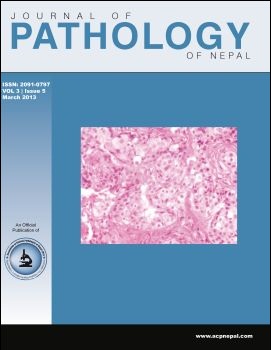Micronuclei and sialic acid as markers of genotoxic damage in tobacco-related oral lesions
DOI:
https://doi.org/10.3126/jpn.v3i5.7862Keywords:
Free sialic acid, Micronuclei, Oral cancer, Premalignant, Protein bound sialic acid, TobaccoAbstract
Background: Carcinogens and co-carcinogens act in an additive, synergistic and antagonistic manner. Tobacco is the most common carcinogen related to oral cancer. The aim of this study was to assess the effect of tobacco on the oral epithelium by evaluating genotoxic damage to cells as quantitated by micronuclei and also the alterations to the cell membrane were correlated by the measurement of free sialic acid and protein-bound sialic acid in saliva and in serum.
Materials and Methods: Blood samples collected from 15 untreated oral squamous cell carcinoma patients, 15 patients with oral precancerous conditions, 15 tobacco chewers without clinically evident lesion and 15 non-tobacco chewers. Serum and salivary sialic acid levels both in free and bound form were measured spectrophotometrically. Smear was taken from the same patient from the suspicious site and assessment of micronuclei was done by acridine orange method.
Results: Serum free sialic acid and micronuclei assessment showed greater level of signifi cance (P=?0.05) between all other groups. This implies it’s potential use as an indicator of oral cancer. Predictability of occurrence of oral Cancer = 0.561+ 0.005× serum protein-bound sialic acid+ 0.244 serum free sialic acid + 0.71 M, where M=mean of micronuclei in 500 exfoliated oral cells. Predictability of occurrence of oral Premalignancy = 0.13+ 0.909× serum free sialic acid+ 0.045 M, where M=mean of micronuclei in 500 exfoliated oral cells.
Conclusion: Micronuclei, serum and salivary sialic acid levels may be a good marker for prediction of premalignancy and oral squamous cell carcinoma transformation.
Journal of Pathology of Nepal (2013) Vol. 3, No.1, Issue 5, 379-385
Downloads
Downloads
Published
How to Cite
Issue
Section
License
This license enables reusers to distribute, remix, adapt, and build upon the material in any medium or format, so long as attribution is given to the creator. The license allows for commercial use.




